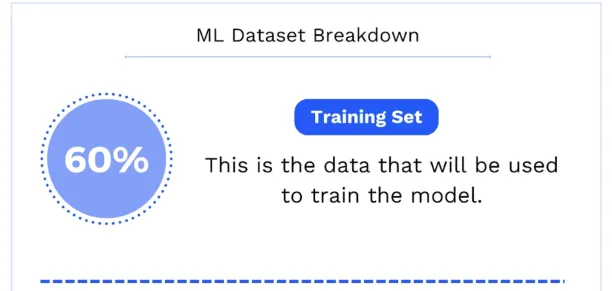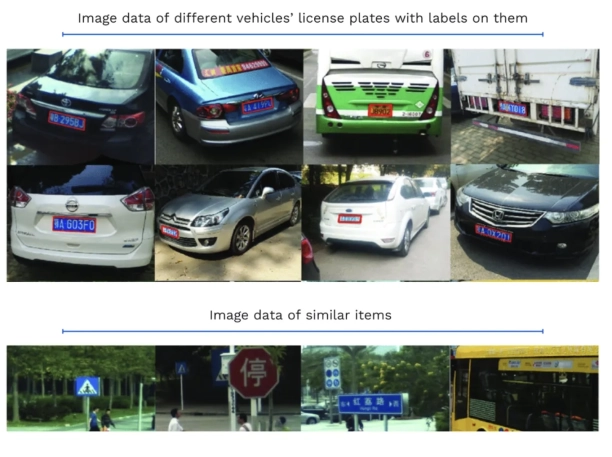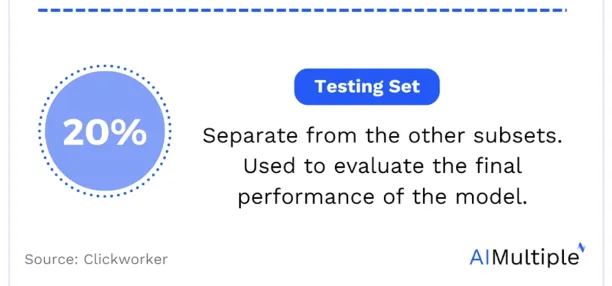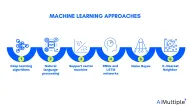Data is required to leverage or build generative AI or conversational AI solutions. You can use existing datasets available on the market or hire a data collection service.
Explore different types of existing datasets: custom human-generated, custom machine-generated, natural language processing, open, public government, image, audio, and healthcare datasets to train your machine-learning models.
Dataset categories
Sourcing a dataset depends on the requirements and scope of the project. This section highlights some popular sources of acquiring datasets to train AI and machine learning models.
Custom human generated datasets
| Dataset Name | Description | Free / Paid | Latest update |
|---|---|---|---|
| LXT | Freshly collected/generated data via a 4.5+ million crowd | Paid | March 2024 |
| Appen | Freshly collected/generated data via a 1+ million crowd | Paid | February 2025 |
| Amazon Mechanical Turk | Freshly collected/generated data via a 0.5+ million crowd | Paid | September 2024 |
| Telus International | Freshly collected/generated data via a 1+ million crowd | Paid | April 2024 |
Notes:
- All lists are compiled from dataset websites and sorted by their last updated dates, from the most recent to the oldest, except for our top sponsor at the very top.
- Quantities in the description column may change over time.
- “Free for non-commercial use” means the dataset is free for researchers and academicians.
Datasets can also be prepared with fresh data that humans collect or generate. Data collection services and companies offer vast pools of workers that help prepare human-generated datasets for machine learning.
Some popular names include: LXT, Appen, Amazon Mechanical Turk, and Telus International.
Custom machine-generated datasets
| Dataset Name | Description | Free / Paid | Latest update |
|---|---|---|---|
| OpenAI GPT-4 | LLM for AI training data generation | Freemium | April 2025 |
| Hazy | Synthetic data platform | Paid | November 2024 |
| Synthesis AI | Synthetic data generation for computer vision tasks | Paid | November 2024 |
Customer machine-generated datasets made by generative AI tools, particularly for models like Generative Adversarial Networks (GANs), have transformed the landscape of data creation and augmentation.
Creating datasets using generative AI addresses several challenges in machine learning. Studies have used LLMs to generate training data for machine learning models.1
When collecting real-world data is expensive, time-consuming, or ethically challenging, generative models can supplement or even replace traditional data collection methods.
For instance, medical imaging for radiology datasets can be augmented using GANs to generate more samples of rare conditions, making it easier to train models to detect and diagnose them.
Additionally, in domains like computer vision (CV), generating diverse data helps mitigate model overfitting and improve the stability of the trained models.
When used carefully alongside real data, this synthesized data can help train more effective and accurate machine learning models while saving resources and time in the data collection phase.
Natural language processing datasets
| Dataset Name | Description | Free / Paid | Latest update |
|---|---|---|---|
| Wikipedia Links Data | Cross-document coreference dataset labeled via Wikipedia links | Free | Ongoing |
| Amazon Reviews Dataset | Product reviews and metadata for sentiment analysis, recommendations | Free | October 2024 |
| The Big Bad NLP Database (BBNLPDB) | Over 300 datasets for NLP models | Free | January 2023 |
NLP datasets are used for speech recognition, text analytics, and language translation. They are large and require heavy computational power.
Open datasets
| Dataset Name | Description | Free / Paid | Latest update |
|---|---|---|---|
| Kaggle Datasets | Open data from competitions, companies, and students | Free | Ongoing |
| Google Dataset Search | Open source dataset search engine | Free | Ongoing |
| GitHub Datasets List | Library of datasets across domains | Free & Paid | May 2025 |
| LAION-5B | 5 billion image-text pairs for training vision-language models | Free | August 2024 |
| AWS Public Datasets | Wide-ranging datasets including biology, meteorology, astronomy | Free | March 2024 |
These ready-to-use datasets are freely available online for anyone to download, modify, and distribute without legal or financial restrictions.
They are regularly updated and compatible with most ML frameworks. The only drawback is that open datasets lack personalization.
Public government datasets
| Dataset Name | Description | Free / Paid | Latest update |
|---|---|---|---|
| Data USA | Over 47,000 U.S. government reports | Free | Ongoing |
| Data.Gov.uk | Over 47,000 UK government datasets | Free | Ongoing |
| EU Open Data Portal | Over 1.6 million datasets from EU institutions | Free | Ongoing |
| HealthData.gov | Over 2,000 health-related datasets from the U.S. government | Free | Ongoing |
These datasets are used for government projects implemented for the public. For example, they can include a certain population’s census or demographic data.
These datasets can also be used to make policies or train AI/ML models for immigration decision-making, chatbots that answer citizen queries, city infrastructure planning systems, etc.
Image datasets
| Dataset Name | Description | Free / Paid | Latest update |
|---|---|---|---|
| Baidu ApolloScape | Annotated images for autonomous driving | Free | Ongoing |
| COCO Dataset | Over 200K labeled images for object detection and segmentation | Free | Ongoing |
| Google’s Open Images | Over 9 million annotated images | Free | Ongoing |
| ImageNet | Over 14.1 million annotated images | Free for non-commercial use | Ongoing |
| Waymo Open Dataset | Image dataset for autonomous vehicle research | Free for non-commercial use | Ongoing |
Image datasets include both image and video data. They are used to train computer vision systems for facial recognition, autonomous vehicle systems, retail security systems, and other applications. These datasets require high-quality image annotation.
Audio datasets
| Dataset Name | Description | Free / Paid | Latest update |
|---|---|---|---|
| Common Voice | Crowdsourced database for speech recognition data | Free | Ongoing |
| Free Music Archive (FMA) | Over 100,000 music tracks across 161 genres, metadata, and features | Free | Ongoing |
| Speech Commands Dataset | Over 65,000 crowdsourced speech data units for keyword spotting | Free | Ongoing |
| ESC-50 | 2,000 labeled environmental audio recordings across 50 classes | Free | December 2024 |
These datasets train AI/ML models for voice recognition, music recognition, etc.
Healthcare datasets
| Dataset Name | Description | Free / Paid | Latest update |
|---|---|---|---|
| MIMIC Critical Care Database | Health-related data of over 40,000 ICU patients from Beth Israel Deaconess | Free | Ongoing |
| HealthData.gov | Over 2,000 U.S. health-related datasets (also listed under Public Government) | Free | Ongoing |
These datasets are used to train medical imaging systems or medical diagnosis systems. They are usually large in size and require heavy computational and high-quality medical annotation.
To learn more, check out LLM models in healthcare.
What are ML datasets?
A machine learning dataset is a structured data collection specifically gathered and prepared to train machine learning models. These datasets for ML act as examples that help the model learn patterns, extract meaningful features, and make predictions on unseen data.
Depending on the task, the machine learning dataset may consist of various data types, including:
- Text data: Used in applications like natural language processing, sentiment analysis, and machine translation.
- Image data: Commonly used in computer vision and convolutional neural networks for tasks like handwritten digits recognition or steel plate faults detection.
- Audio data: For speech recognition or sound classification tasks.
- Video data: For object tracking or real-time video analysisç
- Numeric data: Used in regression or classification tasks, sometimes coming from mass spectrometry data or time stamp logs.
Most machine learning projects begin with raw data, which is then labeled or annotated. This labeling helps the machine learning system understand the expected outcome for classification, regression, or other predictive tasks.
A good dataset, often sourced from open, public, or specialized machine learning repositories, can significantly improve model performance.
Why prepare datasets for machine learning?
Preparing and choosing high-quality datasets is one of the most crucial steps in developing artificial intelligence systems. Many organizations recognize that data preparation can make or break their machine learning projects.
The quality of the training data affects how well models generalize to real-world scenarios and how accurately they handle specific problems. There are three key purposes of a machine learning dataset:
To train the model
The training set teaches the machine the relationships and patterns within the data. This involves feeding annotated or labeled data, allowing the model to adjust its parameters and improve its predictions on similar inputs.
To measure model accuracy
After training, the testing dataset (or test set) is used to evaluate the model’s performance. This helps determine how well the model handles unseen data, and whether it’s overfitting to the training set or learning meaningful patterns.
To improve the model post-deployment
Once deployed, machine learning models are often refined using additional collected data, helping them adapt to new conditions or classes. Validation sets also help tune and prevent overfitting.
Working with a data partner
Preparing datasets can be resource-intensive, especially when dealing with extensive collections, missing values, or complex annotations. Many organizations handle this process with a data collection or generation service provider.
You can collaborate with a data crowdsourcing platform or company specializing in data science services to create domain-specific datasets, whether you need machine learning datasets for sentiment analysis, text classification, or image-based tasks like identifying one hundred plant species.
Sometimes, data is gathered through web scraping or accessed through tools like Google Dataset Search or open data initiatives.
For specialized needs, such as datasets for deep learning models or computer vision systems, relying on curated public datasets or free datasets ensures that the training data covers the necessary range of examples and classes.
You can also select a data partner based on specific data types:
- 7+ Video Data Collection Services & Selection Criteria
- 10+ Image Data Collection Services
- 10+ Speech Data Collection Services
Types of ML datasets
The whole dataset that is collected is separated into three subsets, which are as follows:
1. Training dataset

This is one of the most important subsets of the whole dataset, comprising about 60%. This set consists of the data initially used to train the model. In other words, it helps teach the algorithm what to look for in the data.
For instance, a vehicle license plate recognition system will be trained with image data with labels indicating the location (e.g., front or rear of the car) and the data format of the license plates of vehicles and similar objects to learn what to detect and what to avoid.

Figure 1. Sample dataset for a license plate detection system.2
2. Validation dataset

This subset is about 20% of the total dataset and is used to evaluate all the model parameters after the training phase. The validation data is known data that helps identify any shortcomings in the model. This data is also used to identify if the model is overfitting or underfitting.
3. Test dataset

This subset is input at the final stage of the training process and accounts for the last 20% of the dataset. The data in this subset is unknown to the model and is used to test the accuracy of the model. This dataset will show how much your model has learned from the previous two subsets.
Conclusion
Selecting the right dataset is a foundational step in any machine learning or AI project. Whether you opt for human-generated data, machine-generated synthetic data, or freely available open datasets, the key is aligning your data choice with your project’s specific goals and challenges.
High-quality and well-prepared datasets directly influence how effectively a model learns, generalizes, and performs in real-world applications.
Organizations and practitioners can better navigate the complexities of AI development by understanding the types and roles of datasets, training, validation, and test sets, and by exploring the rich ecosystem of available data sources.
Careful attention to data quality, relevance, and diversity ensures models are accurate and adaptable to evolving needs.
FAQ
Where to get datasets for ML?
To find datasets for machine learning, data scientists can explore various data repositories offering diverse datasets, including demographic data, economic and financial data, and public government data. These curated datasets cover a range of applications, such as natural language processing, sentiment analysis, computer vision, and healthcare.
Resources like open datasets, free datasets, and public datasets provide high-quality training data, validation datasets, and test datasets in various data formats like CSV files. Popular sources include government portals, academic institutions, and organizations like the International Monetary Fund, offering extensive collections of datasets for ML projects, predictive models, and deep learning algorithms.
What kind of dataset is good for machine learning?
A good machine learning dataset is a high-quality, diverse dataset with rich metadata, suitable for specific tasks like natural language processing, image classification, or sentiment analysis, and is often available from public data repositories or open datasets.



Comments
Your email address will not be published. All fields are required.